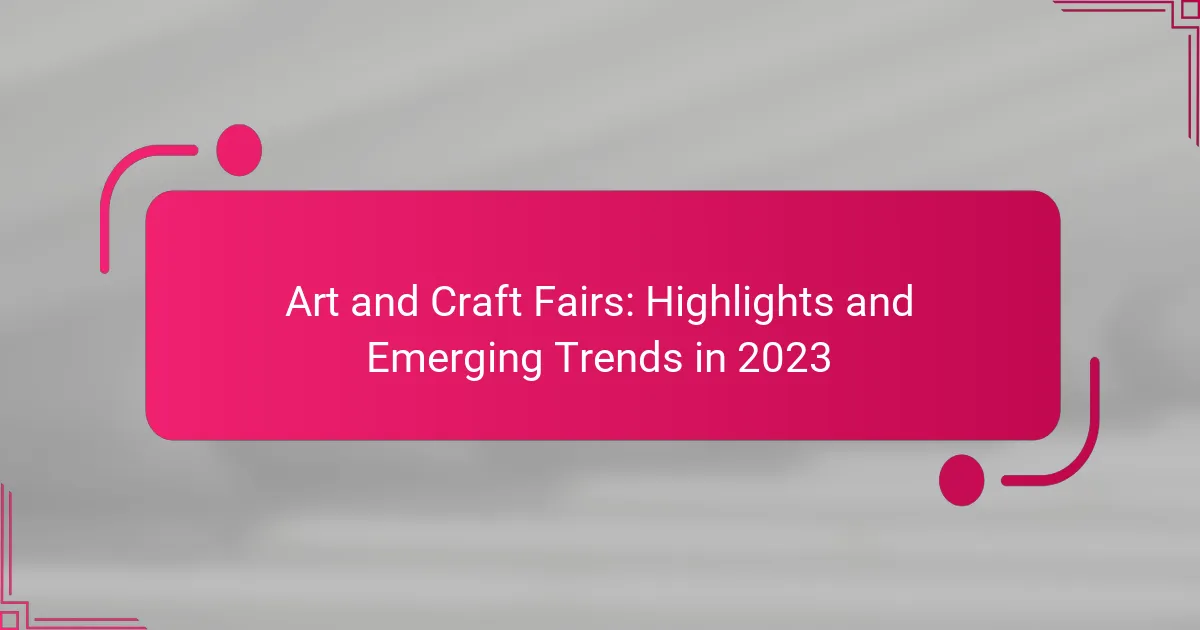Art and craft fairs in 2023 offer unique experiences that blend creativity and community engagement. Attendees can expect hands-on workshops, live demonstrations, and direct interactions with local artisans. Emerging trends focus on sustainability, digital integration, and interactive elements that enhance visitor experiences. These events not only promote local economies but also foster cultural exchange and community identity.
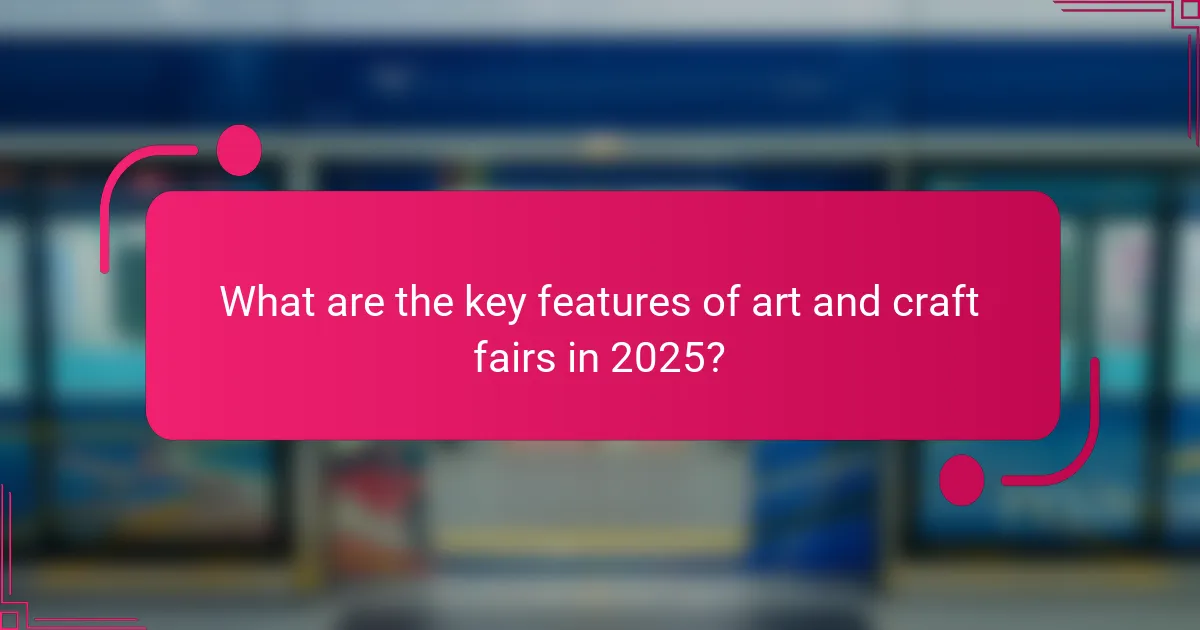
What are the key features of art and craft fairs in 2025?
Art and craft fairs in 2025 will feature enhanced interactivity, sustainability, and digital integration. Emerging trends include virtual reality experiences, eco-friendly materials, and a focus on local artisans. Attendees will increasingly seek unique, handmade items that reflect personal stories. These fairs will also prioritize community engagement through workshops and live demonstrations.
How do art and craft fairs foster community engagement?
Art and craft fairs foster community engagement by creating spaces for connection and collaboration among local artists and residents. These events promote social interaction through workshops, demonstrations, and shared experiences. Attendees often form lasting relationships, enhancing community cohesion. Additionally, fairs support local economies by encouraging the purchase of handmade goods, which strengthens ties between consumers and creators. This collective participation in the arts cultivates a sense of belonging and pride within the community.
What role do local artisans play in these events?
Local artisans play a crucial role in art and craft fairs by showcasing unique handmade products. Their presence enhances the diversity of offerings and fosters community engagement. Artisans often share their stories, connecting consumers to the cultural significance of their crafts. In 2023, trends show increased interest in sustainable materials and traditional techniques, highlighting artisans’ commitment to quality and heritage.
Which types of crafts are most popular in different regions?
Crafts popular in different regions include pottery in the Southwest, quilting in the Midwest, and woodworking in the Pacific Northwest. Each region showcases unique cultural influences and craftsmanship styles. For example, the Southeast is known for its vibrant folk art, while the Northeast emphasizes traditional textile arts. Emerging trends in 2023 highlight a growing interest in sustainable materials and techniques across all regions.
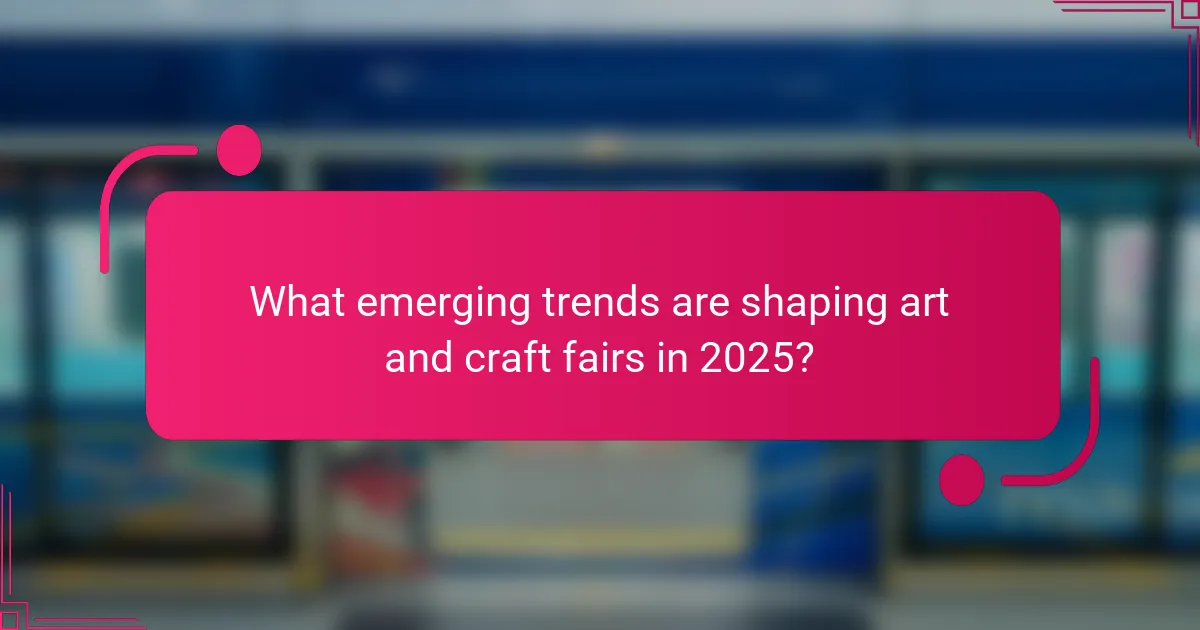
What emerging trends are shaping art and craft fairs in 2025?
Art and craft fairs in 2025 are increasingly shaped by sustainability, technology integration, and community engagement. Sustainability is emphasized through eco-friendly materials and practices. Technology enhances visitor experiences with virtual reality and online platforms. Community engagement fosters local artist showcases and interactive workshops. These trends reflect a shift towards more inclusive and environmentally conscious events.
How is technology influencing the experience of attendees?
Technology significantly enhances attendee experiences at art and craft fairs in 2023. Innovations like augmented reality enable virtual interactions with artworks, enriching engagement. Mobile apps streamline event navigation and provide real-time updates, improving accessibility. Social media platforms amplify community interaction, fostering connections among artists and attendees. Additionally, digital payment systems simplify transactions, enhancing convenience and efficiency. These technological advancements create immersive environments that attract diverse audiences and elevate overall satisfaction.
What sustainable practices are being adopted by organizers?
Organizers of art and craft fairs are increasingly adopting sustainable practices. These include using eco-friendly materials, reducing waste through recycling initiatives, and promoting local artisans to minimize transportation emissions. Additionally, many events are implementing digital ticketing to decrease paper usage and encourage sustainable transportation options for attendees.
Which new forms of art are gaining traction at these fairs?
Innovative art forms gaining traction at fairs in 2023 include immersive installations, digital art, and sustainable crafts. Immersive installations engage audiences through interactive experiences, while digital art leverages technology for unique expressions. Sustainable crafts emphasize eco-friendly materials, appealing to environmentally conscious consumers.
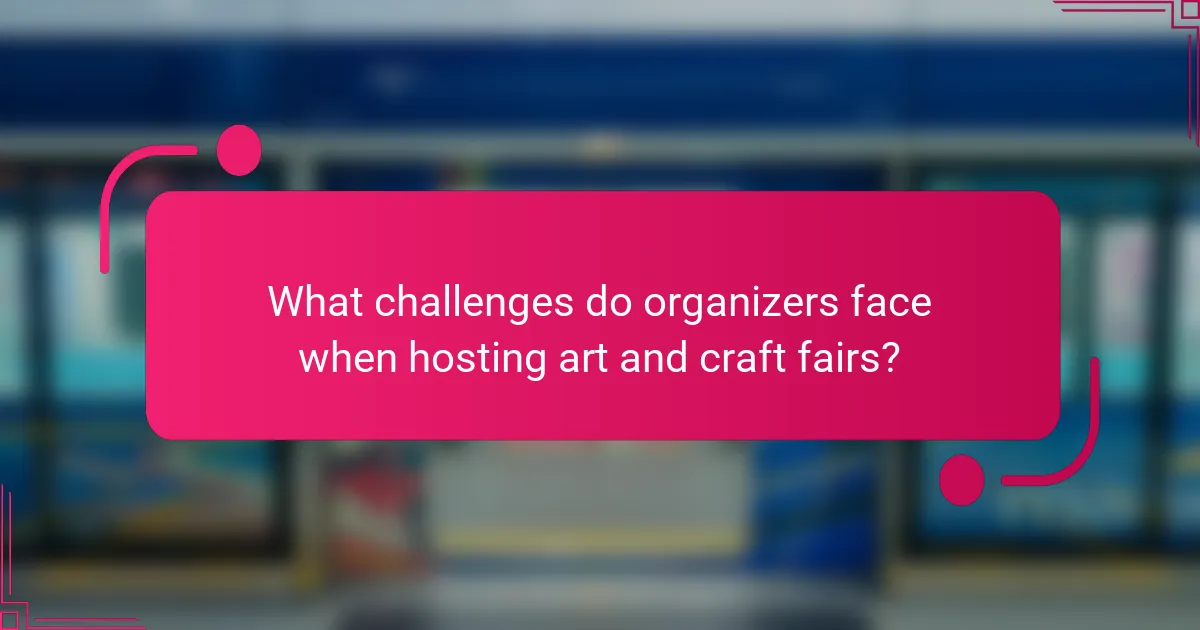
What challenges do organizers face when hosting art and craft fairs?
Organizers face several challenges when hosting art and craft fairs, including securing funding, managing logistics, and attracting participants. Competition from online marketplaces has increased, making it essential to create unique experiences that draw attendees. Weather conditions can also impact turnout, requiring contingency plans. Additionally, ensuring a diverse range of vendors can be difficult, yet it is crucial for attracting a broad audience. Effective marketing strategies are necessary to promote the event and engage the community.
How do economic factors impact attendance and vendor participation?
Economic factors significantly influence attendance and vendor participation at art and craft fairs. Economic stability encourages higher consumer spending, leading to increased foot traffic. Conversely, economic downturns can reduce attendance, as potential visitors may prioritize essential expenses over leisure activities.
Vendor participation often correlates with market conditions; during prosperous times, more artisans are likely to invest in booths and materials. In contrast, during economic uncertainty, vendors may hesitate to participate due to lower expected sales.
Additionally, local economic conditions, such as unemployment rates and disposable income levels, directly impact both attendance and vendor engagement. For instance, regions with higher income levels tend to attract more visitors and vendors, enhancing the fair’s overall success.
What logistical issues commonly arise during these events?
Logistical issues at art and craft fairs often include inadequate space for vendors, poor crowd management, and insufficient signage. These factors can lead to confusion and reduced sales. Additionally, weather-related challenges can disrupt attendance and logistics. Coordination with local authorities may also present difficulties, affecting permits and safety regulations.
How are organizers addressing accessibility for diverse audiences?
Organizers are enhancing accessibility at art and craft fairs through various strategies. They are implementing wheelchair ramps, designated seating areas, and accessible restrooms. Additionally, many fairs now provide materials in multiple formats, such as braille and large print, to cater to visually impaired attendees. Sign language interpreters are often available for workshops and demonstrations, ensuring inclusivity for hearing-impaired visitors. Furthermore, organizers are actively seeking feedback from diverse audiences to continuously improve accessibility measures.
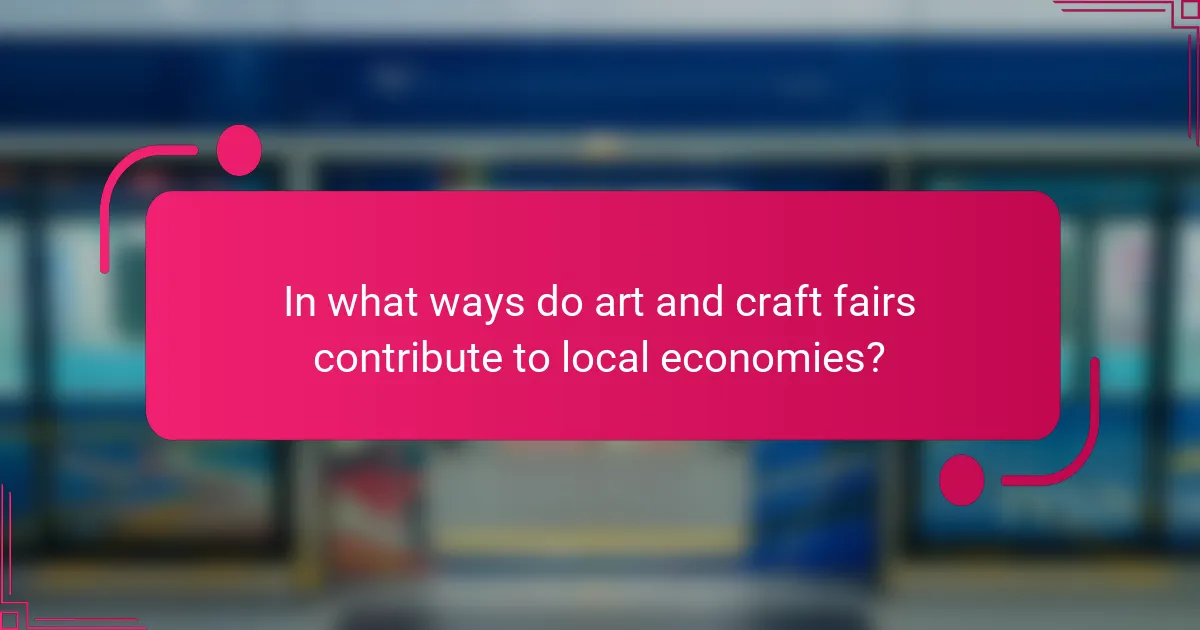
In what ways do art and craft fairs contribute to local economies?
Art and craft fairs significantly boost local economies by attracting visitors and promoting local artists. They create jobs, stimulate spending, and enhance community engagement.
These events generate direct revenue through vendor sales, ticket sales, and food and beverage purchases. For instance, art fairs can increase local sales by up to 30% during the event.
Art and craft fairs also foster tourism, drawing visitors who contribute to local businesses such as hotels and restaurants. This influx of visitors can lead to long-term economic benefits as they return or recommend the area to others.
Furthermore, these fairs promote cultural exchange and community identity, strengthening social ties and encouraging local pride. As a result, they play a vital role in sustaining vibrant local economies.
What are the measurable benefits for small businesses and artisans?
Art and craft fairs offer measurable benefits for small businesses and artisans, including increased visibility, direct sales opportunities, and community engagement. They provide a platform to showcase unique products, connect with customers, and gather feedback. Participation can lead to an estimated 30% increase in brand awareness and a 20% boost in sales during events. Networking with other artisans can also result in collaborative opportunities and shared resources. Overall, these fairs enhance local economies and foster a supportive creative community.
How do these events promote tourism in their regions?
Art and craft fairs significantly boost tourism by attracting visitors to explore local culture and creativity. These events showcase regional artisans, enhancing community visibility and economic growth. They often feature unique local products, drawing both tourists and locals, which increases foot traffic and stimulates nearby businesses. Additionally, art and craft fairs foster a sense of community, encouraging repeat visits and creating lasting memories for attendees.
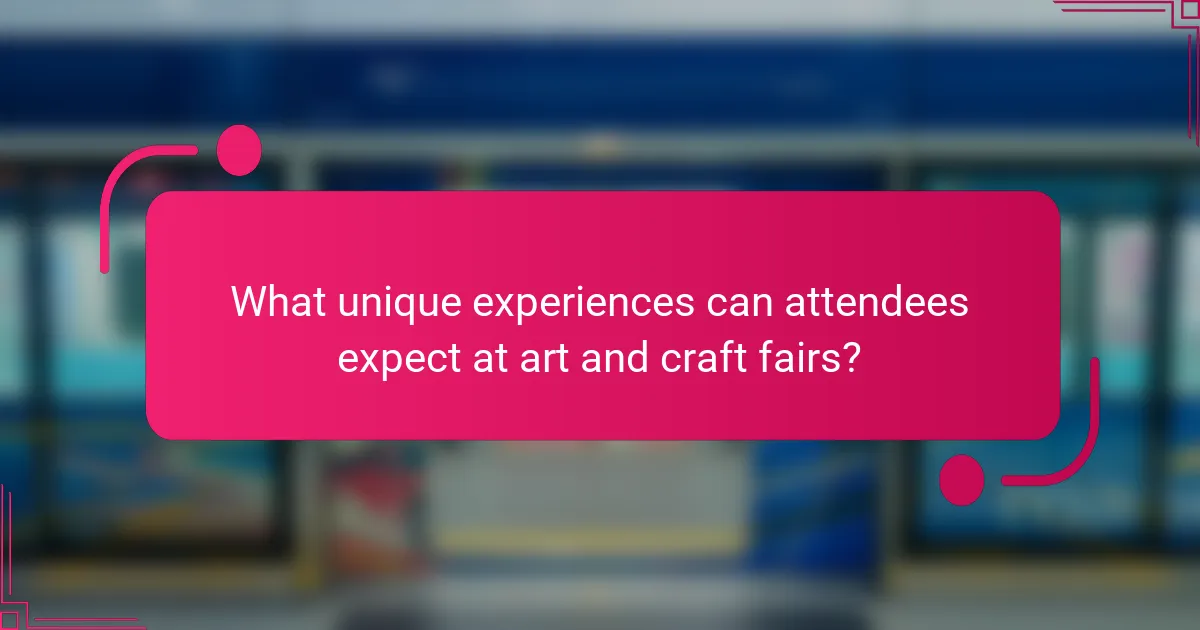
What unique experiences can attendees expect at art and craft fairs?
Attendees at art and craft fairs can expect unique experiences such as direct interactions with artists, hands-on workshops, and exclusive access to limited-edition pieces. These events foster community engagement and provide opportunities to discover emerging trends in creativity. Visitors often enjoy immersive installations and live demonstrations, enhancing their appreciation for various art forms. Additionally, many fairs feature local food vendors, creating a vibrant atmosphere that celebrates both art and culture.
Which interactive activities are becoming more prevalent?
Interactive activities at art and craft fairs are increasingly focused on hands-on experiences. Workshops and live demonstrations allow attendees to engage directly with artists and craftspeople. Virtual reality experiences are also gaining traction, providing immersive ways to explore art. Additionally, collaborative art projects encourage community involvement and creativity.
How do workshops enhance the fair experience for visitors?
Workshops significantly enhance the fair experience for visitors by providing interactive learning opportunities. They allow participants to engage directly with artists and craftspeople, fostering a deeper appreciation for the creative process. Additionally, workshops often cover diverse topics, from traditional techniques to modern trends, accommodating various skill levels. This hands-on approach not only enriches knowledge but also creates memorable experiences, making fairs more enjoyable and educational for attendees.
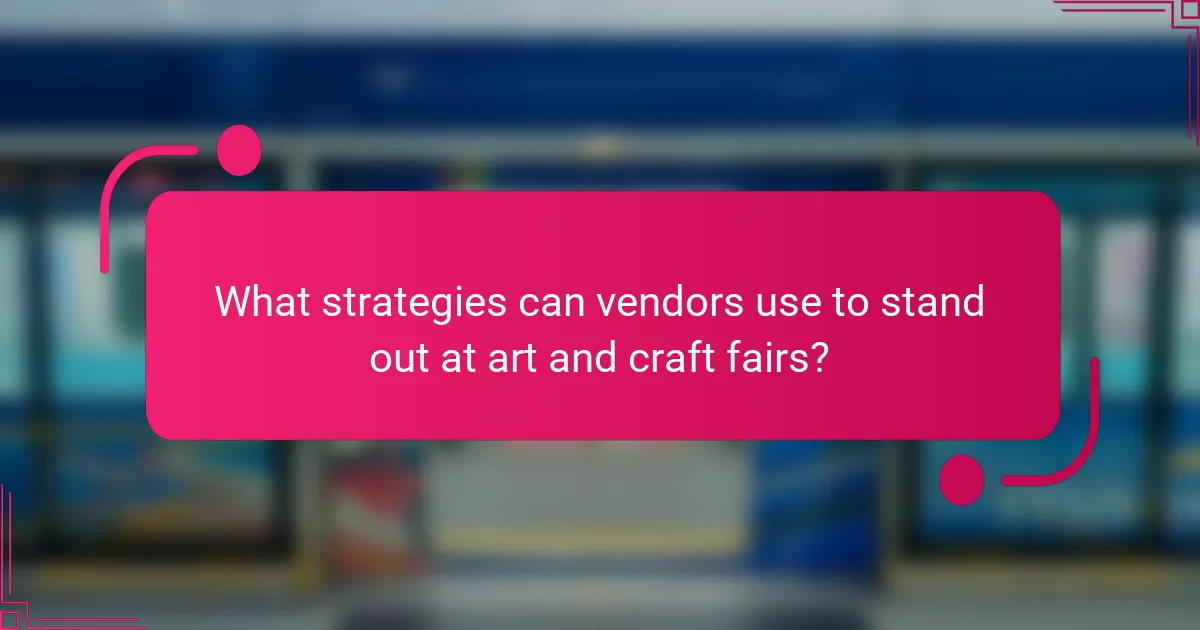
What strategies can vendors use to stand out at art and craft fairs?
Vendors can stand out at art and craft fairs by focusing on unique product presentation and engaging customer interactions. Creative booth designs attract attention, while storytelling about products enhances emotional connections. Offering live demonstrations showcases craftsmanship and draws in crowds. Utilizing social media for promotion before and during the event increases visibility and traffic. Finally, building relationships with fellow vendors can lead to collaborative opportunities and shared audiences.
How can effective branding attract more customers?
Effective branding can significantly attract more customers by creating a strong identity and emotional connection. A well-defined brand resonates with target audiences, enhancing recognition and trust. In 2023, art and craft fairs leverage unique branding strategies, showcasing local artisans and sustainable practices. These trends not only draw attention but also foster community engagement, leading to increased customer loyalty.
What pricing strategies work best for selling crafts?
Competitive pricing strategies work best for selling crafts at art and craft fairs. Consider value-based pricing, which reflects the perceived value of your unique creations.
Additionally, tiered pricing can cater to different customer segments, allowing for budget-friendly options alongside premium items. Bundle pricing encourages larger purchases by offering discounts on multiple items.
Market research is crucial; analyze competitors’ pricing to ensure your rates are attractive yet profitable. Seasonal promotions can also boost sales during peak times.
What common mistakes should vendors avoid at these events?
Vendors should avoid common mistakes such as poor display organization, inadequate product pricing, and lack of customer engagement. Effective presentation and interaction can significantly enhance sales and customer experience. Additionally, failing to promote the event beforehand can lead to lower foot traffic. Understanding the target audience is crucial for tailoring offerings and maximizing impact.
What expert tips can enhance the overall vendor experience?
To enhance the overall vendor experience at art and craft fairs, focus on effective communication, streamlined logistics, and engaging displays. Clear communication fosters relationships, while efficient setup and breakdown processes save time. Interactive and visually appealing displays attract more visitors, boosting sales. Offering workshops or demonstrations can also create a memorable experience, encouraging repeat attendance.
